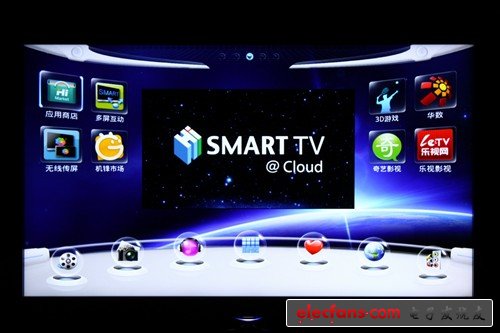According to foreign media reports, people have expected the television equipment industry to set off an "industrial revolution" of their own for a long time in the past, but such expectations have never been realized. Judging from the current situation, the TV industry still has huge room for development, mainly due to the fact that TV operators still have unique advantages in transmitting high-quality TV content. At the same time, Internet TV has also developed to a certain extent in 2012. Although this development rate is still far from people's expectations, the two major factors of content and user interface still greatly restrict the development of Internet TV. So, for the upcoming 2013, what development trends will the TV industry show? In response, John Paul TItlow, a special contributor to the US technology media Readwrite, made five predictions for the development trend of the television industry in 2013. The details are as follows: 1. The rise of social TV Social TV (Social TV), as the name implies, is to seamlessly integrate social media such as Twitter and Facebook with TV, making TV an important terminal for social media. The purpose of social TV is simple: to allow TV viewers in different places to easily share and discuss the TV programs they are watching. In this way, the audience can not only comment on the current popular TV series in time, but also celebrate the goal while watching sports events. In fact, the concept of social TV has begun to appear more and more frequently in tech blogs and IT media articles in recent years. In the upcoming 2013, we believe that the boundaries between "TV" and "social TV" will become more blurred and will have a huge impact on the TV production process. Among them, the most obvious example is the US market research agency Nielsen announced in late 2012 that it will join hands with Twitter to launch a new ratings survey service to monitor Twitter user comments on certain TV programs. It is reported that this new service is called "Nielsen-Twitter Rating" (Nielsen Twitter TV RaTIng) and will be officially launched next fall. Its main function is to monitor Twitter users watching ABC TV station "Monday Night Football" (Monday Night Football), the latest season of "Homeland Security" and other programs, while staying on the "second screen" such as smartphones and tablets Comments and chat messages. We believe that this "second screen" concept will be further developed in 2013. According to statistics, about 90% of tablet users will use the tablet when watching TV, but so far, TV content producers and application developers have not yet found a suitable commercial model for this. However, there are some exceptions. For example, the mobile social TV applications Zeebox and iTV put their positioning in "TV user assistance services", while the services of GetGlue and Miso have crossed the previous "social check-in" category. And began to develop in the direction of "content discovery". At the same time, we believe that you will see more social media content discovery applications in 2013. For example, personalized video applications like Flipboard, including Showyou, Frequency, and Vodio have all changed the way users discover and digest online video by using technologies like Apple AirPlay. Therefore, we believe that these video applications will become more mature in 2013 with the influx of a large number of users. 2. Apple leads the industry standard Whether you are a "fruit powder" or not, an undeniable fact is that Apple has already had a major impact on most of the fields that it has entered. From the information we have collected at present, Apple's enthusiasm for the TV field has not only stayed in the "hobby" of the Steve Jobs era, but has reached Tim Cook. ) And the height of what the current Apple executive team calls "strong interest." Considering that Apple is entering a very mature market, rather than creating a completely new product category on its own. Therefore, even if Apple launches its own high-definition TV products, its sales are unlikely to reach the level of iPad sales. However, I still believe that no matter what kind of TV products Apple will launch in the future, it will set a new standard for the industry to display online video content on TV screens. 3. Original TV shows Internet companies invest heavily in original video programming is a major trend in 2012. These streaming media platforms including Hulu, Netflix and YouTube have invested heavily in their own original video content, but the original content produced by these platforms is limited to Play through the network. In this regard, Google (Weibo) seems to have made up its mind to start its own reform. The search giant has now begun to eliminate the worst performing products in its own ecological chain, and has begun to try to launch a strong "TV style" "Digital media content. For TV content that is only open to the Internet, the biggest challenge is whether it can get the same ratings as when broadcast through traditional TV channels. Currently, a new season of some episodes including "House of Cards" and the popular sitcom "Arrested Development" is no longer available through Fox TV Network, but is exclusively conducted by Netflix Issuing, whether they can still continue the previous excellent performance has become one of the biggest doubts in people's minds. You know, this is the first bold attempt of a popular TV series to abandon the traditional TV network and switch to an Internet streaming platform. We believe that the performance of the new season of "Restricted Development" will play an important role in the future Internet TV content. And once Netflix is ​​so successful because of "Blocked Development", streaming platforms including Hulu and YouTube will compete to emulate Netflix's digital media development model. 4. The Control Revolution As bad as the current Internet TV interface is, it also includes the current TV control device, which is what we commonly call the "remote control". In this respect, we believe that after Apple enters the television field, it will still take the lead in this area. The world's largest technology company may greatly simplify the way users interact with TV devices. The button layout of the traditional TV remote control will be greatly simplified, replaced by more user-friendly button icons, and the user interface of the TV screen will follow Apple's consistent design style. Bose, a well-known audio company founded in 1964 by a PhD from the Massachusetts Institute of Technology, is currently trying to simplify the design of TV remote controls. The company ’s VideoWave entertainment system remote control has a touchpad and six buttons, and the remaining buttons are transferred To the TV screen itself. Moreover, the remote control can also be remotely linked to any external device and is compatible with Blu-ray players, XBox 360, Roku and future Apple TVs. In addition, the future TV control methods will not be limited to the single device of the remote control, and the operation methods including voice control and gestures are also expected to appear in the future Internet TV devices. In this respect, we can already see some clues from Kinect, iPad and Siri on Xbox. In fact, the most mentioned feature of Apple TV among the rumors is Siri voice control. At the same time, Google has been trying to integrate its voice search function into more mobile products. 5. The convergence of mobile and TV In 2013, TV equipment will continue to look more like a smartphone. As TV software designers begin to redesign TV user interfaces and Apple AirPlay's functional design becomes more mainstream, the convergence of TV and mobile platforms will continue to develop this year. As mobile video applications mature and consumers become more accustomed to using wireless signals to transmit digital media content, the line between mobile phones and TVs will become blurred. In this regard, ease of use has become a very critical factor. Because consumers are looking forward to getting the same simple operation process as AirPlay provided by Apple: even the least technically savvy consumers can easily transfer the digital media content in their tablet computers to the TV for playback. According to Google's research data, people are most used to using a tablet on the sofa, and the most common activity people use to use a tablet is to watch a video. The Online Publishers Association (Onso Publishers AssociaTIon) after studying the usage habits of tablet users, found that the only major feature that is currently missing from tablet computers is "wireless transmission" (similar to Apple Airplay function) because of the realization You need to rely on a set-top box that supports streaming media, but it is obvious that a TV with an Internet connection is the better choice.
Our Solar lights applied in freeway,avenue,pedestrian,garden,campus,path, military bases,park,driving way,airport,boat dock and so on. LED solar street light relies on solar energy, which is clean, endless and environment-friendly.
The system is mainly composed of solar panel, light source, controller and battery. In daytime, when there is sunshine, the solar panel can convert the solar energy to electric energy and store it in the battery.
At night or rainy or cloudy condition, the battery shall supply power for normal lighting. The controller can judge the brightness of daylight and automatically switch on the light.The whole process is operating in completely automatic mode, without human action.
Solar Street Lights,12-24W Solar Street Light,30-50W Solar Street Light,60W Solar Street Light Yangzhou Bright Solar Solutions Co., Ltd. , https://www.cnbrightsolar.com
